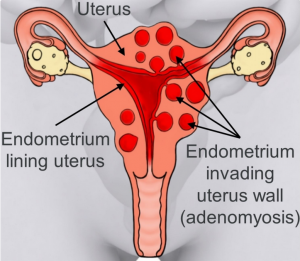Women tend to suffer – and have had
A life . .

Welcome

- Invasive tissue growth.
- Stem cell origins
- Uterine inflammation related to childbirth.
- Developmental origins. …
- Some experts believe that endometrial cells from the lining of the uterus invade the muscle that forms the uterine walls.
More on adenomyosis – from the medical perspective – here (CLICK).
WARNING
All that is below may be new to you.
Some may seem to be outrageous
And even – unbelievable.
If you are one who suffers as so many do.
Maybe a paradigm shift is needed?
I have offered solutions that are simple, natural and work as I have spent over 40 years watching the health of everyone devolving.
How to live well are ignored as the path of least resistance as ‘everybody knows’ drowns out what I would have thought were common sense.
When is enough enough?
What may be in the way?
Here I present a very complicated case – according to the different specialists who trial all the different drugs and wait and see if this worked – and all the while the obvious is missed.
Bodies need ingredients and the circulation working well to heal. And to work appropriately.
Working at the edge of human woes – especially menstrual misery, I often wonder this.
When desperate – and when no thinking you have tried has worked – regardless of how many times you have been operated on, an taken so many medications – let us start at the beginning.
Bodies heal themselves.
If we take out what is blocking this.
WHAT IT IS: (acc to medicos . .)
Adenomyosis – when some of the cells that form the endometrial lining migrated not into the other organs and cavities (and responding to the hormonal shifts for the month – making extra blood, and discharging – creating dramas – but actually bury deep within the womb and start making linings THERE – leaving no place to be shed and thus vast monthly pain.
- Heavy, prolonged menstrual bleeding
- Severe menstrual cramps
- Abdominal pressure and bloating
Who gets this?
Diagnosing
Until recently, the only definitive way to diagnose adenomyosis was to perform a hysterectomy and examine the uterine tissue under a microscope. However, imaging technology has made it possible for doctors to recognize adenomyosis without surgery. Using MRI or transvaginal ultrasound, doctors can see characteristics of the disease in the uterus.
If a doctor suspects adenomyosis, the first step is a physical exam. A pelvic exam may reveal an enlarged and tender uterus. An ultrasound can allow a doctor to see the uterus, its lining, and its muscular wall. Though ultrasound cannot definitively diagnose adenomyosis, it can help to rule out other conditions with similar symptoms.
Another technique sometimes used to help evaluate the symptoms associated with adenomyosis is sonohysterography. In sonohysterography, saline solution is injected through a tiny tube into the uterus as an ultrasound is given.
MRI – magnetic resonance imaging — can be used to confirm a diagnosis of adenomyosis in women with abnormal uterine bleeding. Because the symptoms are so similar, adenomyosis is often misdiagnosed as uterine fibroids. However, the two conditions are not the same. While fibroids are benign tumors growing in or on the uterine wall, adenomyosis is less of a defined mass of cells within the uterine wall. An accurate diagnosis is key in choosing the right treatment.
NOTE
This is NOT a medical site.
I am NOT giving MEDICAL advice
I have been often the only person who has figured out each individual’s reasons behind nothing working YET and returning them and their lives back into order. Using all the ways possible to ensure that normal is followed.
Over decades, through many lineages in many modalities and traditions, I can now offer not only hope – but answers.
Periods are not supposed to hurt. Or take over a woman’s life. When you ignore the medical labeling, and instead look at the systems that run us all changes. Please look at all Stuck Liver Qi (CLICK) /Stuck Liver Blood (CLICK)

We are a whole being – not bits.
Specialists need to see the while – not the bit – hence you listen to Maja – and she had all of this. Most who have Stuck Liver Qi / Stuck Liver Blood:can tick all of these boxes:NOT a gyne problem (only). See also STUCK BLOOD (CLICK)
There is more – the Gall Bladder meridian and its sphere of influence – including all digestion – is at risk. Adenomyoma is a focal region of adenomyosis resulting in a mass, which is difficult to distinguish from a uterine fibroid, although in general the degree to which the contour of the uterus is distorted is less marked in adenomyosis.
Adenomyosis may creep up on women – who may already be used to terrible troubles ‘down there’
Not a happy process – but can be attended to – IF WE UNDERSTAND what set this up.
Freely available information on media outlets accept the standard story that there is no known cause or cure.
As with all conditions that are under the specialist attention in the medical realm – the normal/homeostatic body mechanisms are ignored as a forcing other realities system of control is begun – for some girls the instant they start bleeding
Choices
- 1 – go on the pill
- 2 – get a Mirena implant and
- 3 – hysterectomy).
The tinkering goes on.
Here we see how the endo and other gyne issues are seeded, grown and matured and morph into worsening lives for all. All of this can be undone by the body that is in crisis and ignored. Leading all the conditions that are labeled by the TCM diagnostic processes and the orthodox medical ones. We are not on that part of the line – let us investigate what is common to those who have this and why they have it. We set the context . . there is so much more on Maja’s life in relation to the torrid pregnancies this is more of the aftermath.
She had hyperemesis in both pregnancies – one of twins – one died and left inside mum for 6 weeks – emergency C section. Next baby – placental accretia and then hemorrhaging and near death.
As well . .
Stuck Liver Qi and a combination of Damp/ Stuck Liver Blood.
Fibromyalgia (CLICK)
Massive uterine bleeding, pain and gut and abdominal pain, migraines – eventually got fibroids as well.
Maja did not know she had adenomyosis till she demanded to see her notes years later.
- Curcumin (a constituent of turmeric) lightens periods and helps lower pain and inflammation.
- Zinc helps reduce pain and inflammation.
- Magnesium can help lower inflammation, helps with muscle relaxation and mood.
Chinese herbal research (CLICK)
More Chinese herbal research (CLICK) – Adenomyosis is a benign gynecologic condition in which endometrial tissue invades the myometrium, producing a diffusely enlarged uterus. Common symptoms associated with adenomyosis (AM) include menorrhagia, dysmenorrhea, chronic pelvic pain, metrorrhagia and dyspareunia.[1,2] Women with AM are more likely to suffer from depression and infertility.[3,4] A systematic review of six studies shows that AM seems to have an adverse effect on pregnancy outcomes, leading to a higher risk of preterm birth, gestational age, and preeclampsia.[5] As the definite diagnosis of AM could only be based on histological specimens obtained after hysterectomy, the estimated incidence of AM varied between 5% and 70%.[6] About 70% to 80% of AM cases are reported in women in the fortieth and fifth decades. Between 5% and 25% of AM cases are observed in patients younger than 39 years and only 5% to 10% in women older than 60 years.[6,7] Significant progress has been made in imaging techniques such as transvaginal ultrasound and magnetic resonance imaging, providing a conservative diagnostic approach for AM. Despite the high prevalence and the severe symptoms of AM, the pathogenesis of AM is not well understood. Two main theories are proposed in the literature: invagination of the endometrial basalis as a result of activation of the tissue injury and repair mechanism and metaplasia of displaced embryonic pluripotent Mullerian remnants or differentiation of adult stem cells.[8]
Maybe watch my endometriosis webinar (CLICK)?
A woman’s body’s cry for help.
Multi modality and multi lineage solutions.
Life residue – a constant ‘leave it for later’ as the stressors and distresses pile up.
Life stuck is explained.
Get it all flowing again . . . FREEDOM

